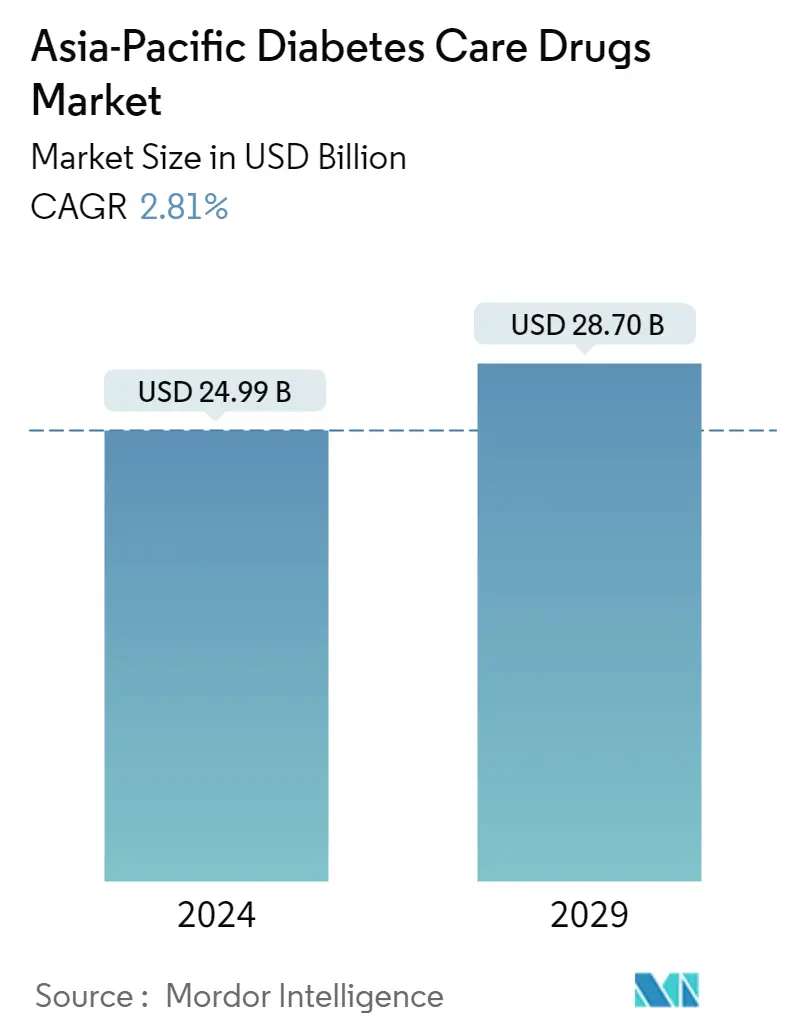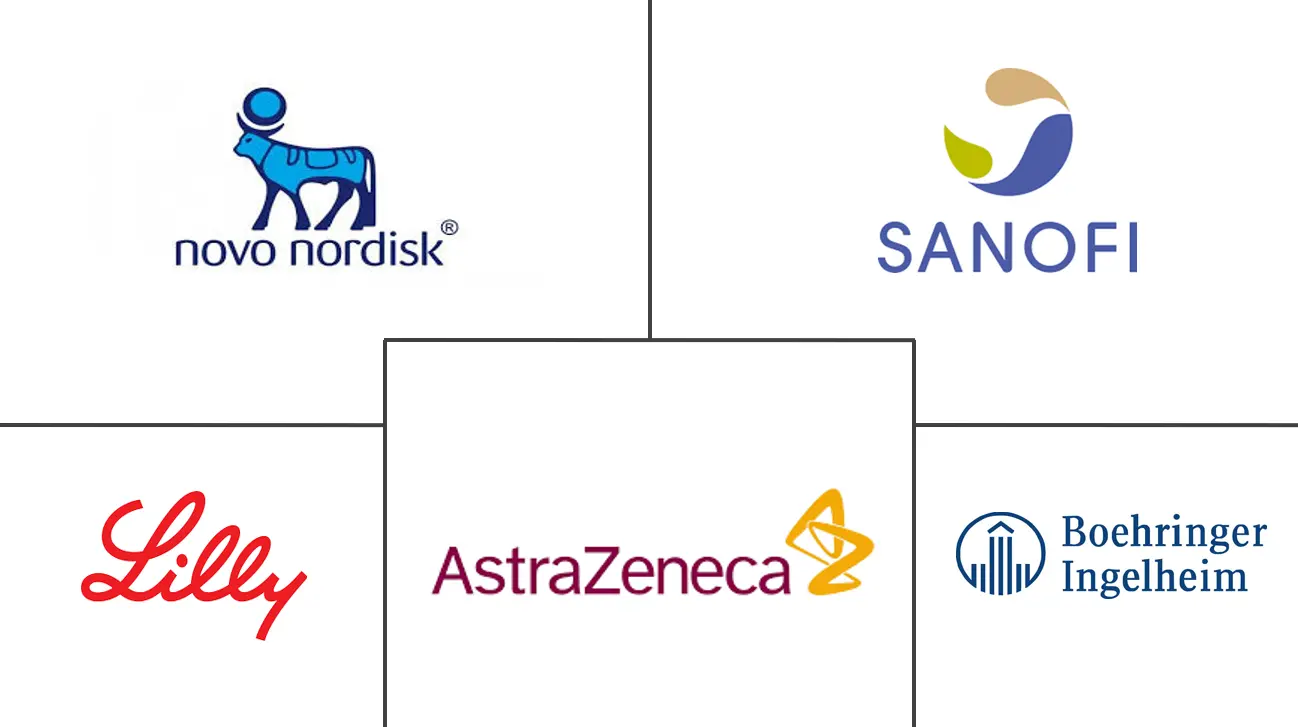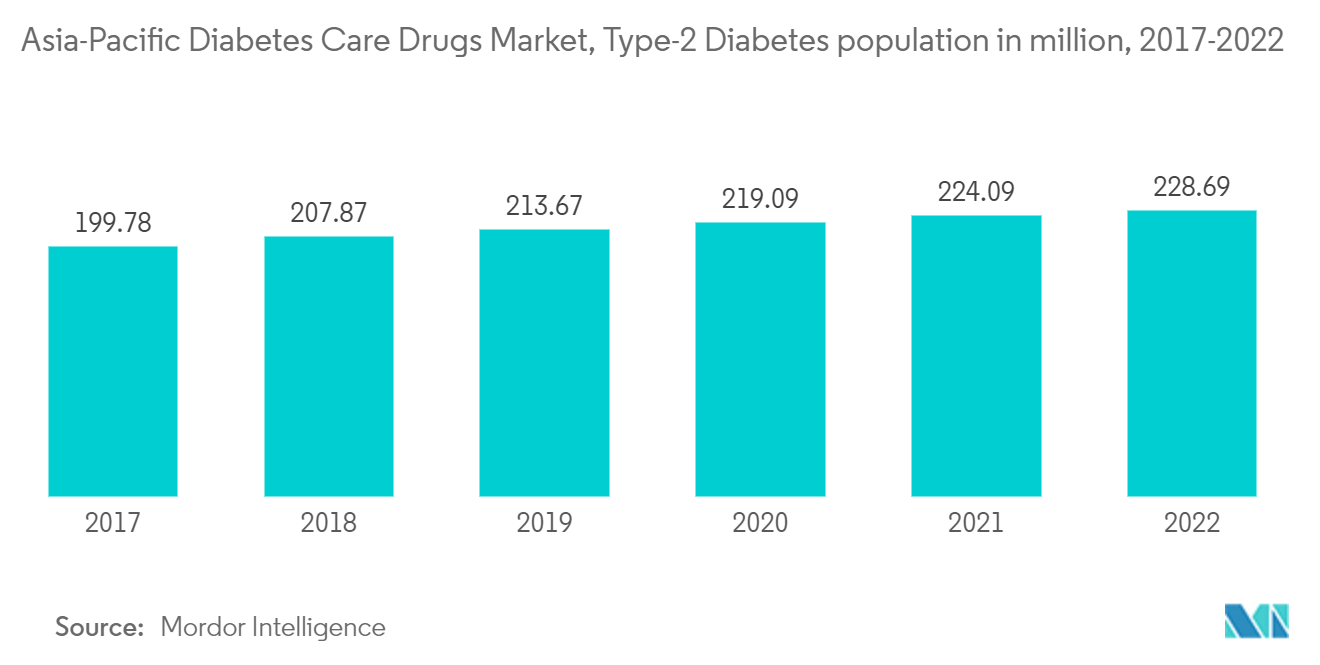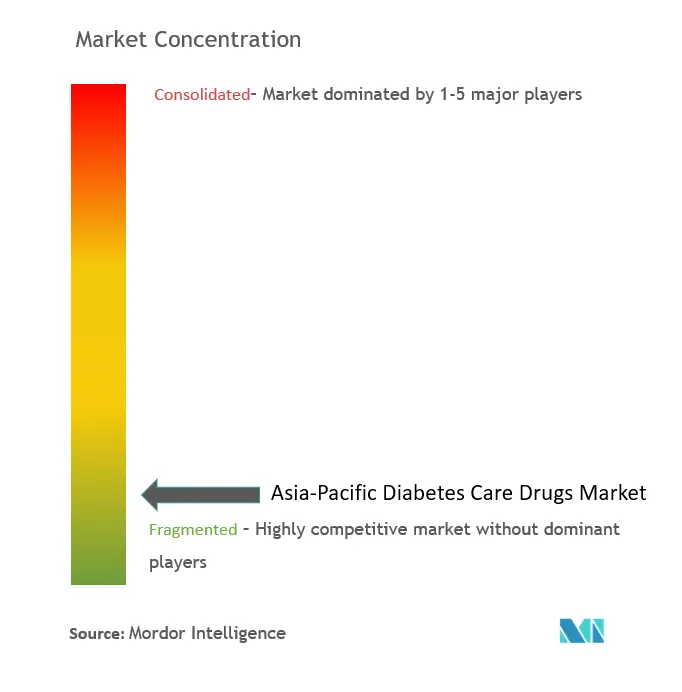Asia-Pacific Diabetes Care Drugs Market Size

| Study Period | 2018 - 2029 |
| Base Year For Estimation | 2023 |
| Market Size (2024) | USD 24.99 Billion |
| Market Size (2029) | USD 28.70 Billion |
| CAGR (2024 - 2029) | 2.81 % |
| Market Concentration | Low |
Major Players
*Disclaimer: Major Players sorted in no particular order |
Asia-Pacific Diabetes Care Drugs Market Analysis
The Asia-Pacific Diabetes Care Drugs Market size is estimated at USD 24.99 billion in 2024, and is expected to reach USD 28.70 billion by 2029, growing at a CAGR of 2.81% during the forecast period (2024-2029).
Over the past few decades, Asian countries have witnessed a rapid increase in diabetes patients, especially those with type 2 diabetes. Developing countries have more than 70% of the global diabetes population. The Asia -Pacific is anticipated to experience considerable growth due to a more geriatric population and rising prevalence of diabetes mainly due to the enhanced stress level, sedentary lifestyles, smoking, and excessive consumption of alcohol that elevates the body's sugar levels have led to the growth of the market.
Moreover, the production basis of certain antidiabetic drug companies in the region also boosted the market growth. However, the increasingly high cost of drugs is considered one of the major restraining factors for the market. According to the OECD iLibrary in Asia-Pacific, about 227 million people live with type 2 diabetes and about half of them are undiagnosed and unaware of developing long-term complications.
Therefore, owing to the aforementioned factors the studied market is anticipated to witness growth over the analysis period.
Asia-Pacific Diabetes Care Drugs Market Trends
Oral Anti-Diabetes Drugs Segment occupies the highest market share in the Asia-Pacific Diabetes Drugs Market in the current year
The oral anti-diabetes drug segment occupied the highest market share in the Asia-Pacific diabetes drug market in the current year and is expected to register a CAGR of about 3.1% over the forecast period.
Oral anti-diabetic drugs have been available internationally and are recommended for use when escalation of treatment for type-2 diabetes is required along with lifestyle management. Oral agents are typically the first medications used in the treatment of type-2 diabetes due to their wide range of efficacy, safety, and mechanisms of action. Antidiabetic drugs help diabetes patients keep their condition under control and lower the risk of diabetes complications. People with diabetes may need to take antidiabetic drugs for their whole lives to control their blood glucose levels and avoid hypoglycemia and hyperglycemia.
Oral anti-diabetic agents present the advantages of easier management and lower cost, so they became an attractive alternative to insulin with better acceptance, which enhances adherence to the treatment. The use of oral anti-diabetes drugs is rising since new-generation oral drugs, such as DPP-4 and SGLT-2, reduce the rate of CV risk in diabetes patients. SGLT-2 and GLP-1 are linked to lowering the mortality rate more effectively than DPP-4 inhibitors. Meglitinide and sulfonylureas are oral hypoglycemic drugs that directly arouse the discharge of insulin from pancreatic beta cells.
The Asia-Pacific region has witnessed an alarming increase in the prevalence of diabetes in recent years. In developing countries such as China and India, the rate of diabetes is at an all-time high. Patients with diabetes require many corrections throughout the day for maintaining normal blood glucose levels, such as oral anti-diabetic medication or the ingestion of additional carbohydrates, by monitoring their blood glucose levels. Leading manufacturers are focusing on technological innovations and the development of advanced products to gain a substantial share of the market.
Thus, owing to the above-mentioned factors, it is expected to drive segment growth over the forecast period.

China holds the highest market share in the Asia-Pacific Diabetes Drugs Market in the current year
In the Asia-Pacific region, China has been recognized as a potential developing market due to the growing diabetic population in this region. China is a mature market with some associated challenges, like slow economic growth, an aging population, and increased competition. In this region, there is a growing preference for oral anti-diabetics among type-2 diabetic patients, thereby leading to the growth of the market studied.
China has the highest market share and contributes significantly to the global diabetes drug market. The country is witnessing a significant increase in the number of generic drug manufacturers. Furthermore, the leading global players in the market studied are facing intense competition from regional players.
Patients can get medicines directly from the hospital pharmacy without a referral. Despite the implementation of national health insurance and its universal coverage, a large proportion of outpatient drugs are still required to be paid for. To reduce the burden on patients, China began implementing a National Essential Medicine System, which aims to guarantee the use of drugs by patients.
As per the National Health Commission, China has taken steps to reduce diabetic patients' medical expenses by reimbursing outpatients for more than half of their medication costs. According to a national metabolic disease clinical research center, more hospitals in China will establish National Metabolic Management Centers (MMC) as part of their exploration of a new model of diabetes treatment, giving a boost to the market over the analysis period.

Asia-Pacific Diabetes Care Drugs Industry Overview
The Asia-Pacific diabetes care drug market is fragmented, with a few key manufacturers gaining a presence in major countries while the remaining market comprises other local or region-specific manufacturers. Mergers and acquisitions that happened between players in the recent past helped companies strengthen their market presence as well as drive innovation.
Asia-Pacific Diabetes Care Drugs Market Leaders
-
Astrazeneca
-
Boehringer Ingelheim
-
Novo Nordisk A/S
-
Eli Lilly and Company
-
Sanofi Aventis
*Disclaimer: Major Players sorted in no particular order

Asia-Pacific Diabetes Care Drugs Market News
- October 2023: Glenmark Pharmaceuticals has introduced Zita, a new medication for the management of Type 2 diabetes in India. This triple-fixed-dose combination drug consists of Teneligliptin, Dapagliflozin, and Metformin. Priced at Rs 14 per tablet, Zita aims to enhance glycemic control in individuals with diabetes. Moreover, it is anticipated to reduce the daily expenses of therapy by 30%, thereby increasing its affordability for patients.
- July 2022: Gan & Lee Pharmaceuticals Co., Ltd. announced that China's National Medical Products Administration (NMPA) cleared its investigational new drug application for GZR4, to improve the management of diabetes. GZR4, a new generation of once-weekly ultra-long-acting insulin, is expected to be dosed once a week by subcutaneous injection in humans to achieve smooth control of basal blood glucose for one week.
Asia-Pacific Diabetes Care Drugs Market Report - Table of Contents
1. INTRODUCTION
- 1.1 Study Assumptions and Market Definition
- 1.2 Scope of the Study
2. RESEARCH METHODOLOGY
3. EXECUTIVE SUMMARY
4. MARKET DYNAMICS
- 4.1 Market Overview
- 4.2 Market Drivers
- 4.3 Market Restraints
-
4.4 Porter's Five Forces Analysis
- 4.4.1 Bargaining Power of Suppliers
- 4.4.2 Bargaining Power of Consumers
- 4.4.3 Threat of New Entrants
- 4.4.4 Threat of Substitute Products and Services
- 4.4.5 Intensity of Competitive Rivalry
5. MARKET SEGMENTATION
-
5.1 Oral Anti-diabetic Drugs
- 5.1.1 Biguanides
- 5.1.1.1 Metformin
- 5.1.2 Alpha - Glucosidase Inhibitors
- 5.1.2.1 Alpha - Glucosidase Inhibitors
- 5.1.3 Dopamine -D2 Receptor Agonist
- 5.1.3.1 Bromocriptin (Cycloset)
- 5.1.4 Sodium-glucose Cotransport -2 (SGLT-2) Inhibitor
- 5.1.4.1 Invokana (Canagliflozin)
- 5.1.4.2 Jardiance (Empagliflozin)
- 5.1.4.3 Farxiga/Forxiga (Dapagliflozin)
- 5.1.4.4 Suglat (Ipragliflozin)
- 5.1.5 Dipeptidyl Peptidase - 4 (DPP-4) Inhibitors
- 5.1.5.1 Januvia (Sitagliptin)
- 5.1.5.2 Onglyza (Saxagliptin)
- 5.1.5.3 Tradjenta (Linagliptin)
- 5.1.5.4 Vipidia/Nesina (Alogliptin)
- 5.1.5.5 Galvus (Vildagliptin)
- 5.1.6 Sulfonylureas
- 5.1.6.1 Sulfonylureas
- 5.1.7 Meglitinides
- 5.1.7.1 Meglitinides
-
5.2 Insulins
- 5.2.1 Basal or Long Acting Insulins
- 5.2.1.1 Lantus (Insulin Glargine)
- 5.2.1.2 Levemir (Insulin Detemir)
- 5.2.1.3 Toujeo (Insulin Glargine)
- 5.2.1.4 Tresiba (Insulin Degludec)
- 5.2.1.5 Basaglar (Insulin Glargine)
- 5.2.2 Bolus or Fast Acting Insulins
- 5.2.2.1 NovoRapid/Novolog (Insulin Aspart)
- 5.2.2.2 Humalog (Insulin Lispro)
- 5.2.2.3 Apidra (Insulin Glulisine)
- 5.2.3 Traditional Human Insulins
- 5.2.3.1 Novolin/Actrapid/Insulatard
- 5.2.3.2 Humulin
- 5.2.3.3 Insuman
- 5.2.4 Biosimilar Insulins
- 5.2.4.1 Insulin Glargine Biosimilars
- 5.2.4.2 Human Insulin Biosimilars
-
5.3 Combination drugs
- 5.3.1 Insulin combinations
- 5.3.1.1 NovoMix (Biphasic Insulin Aspart)
- 5.3.1.2 Ryzodeg (Insulin Degludec and Insulin Aspart)
- 5.3.1.3 Xultophy (Insulin Degludec and Liraglutide)
- 5.3.2 Oral Combinations
- 5.3.2.1 Janumet (Sitagliptin and Metformin)
-
5.4 Non-Insulin Injectable drugs
- 5.4.1 GLP-1 receptor agonists
- 5.4.1.1 Victoza (Liraglutide)
- 5.4.1.2 Byetta (Exenatide)
- 5.4.1.3 Bydureon (Exenatide)
- 5.4.1.4 Trulicity (Dulaglutide)
- 5.4.1.5 Lyxumia (Lixisenatide)
- 5.4.2 Amylin Analogue
- 5.4.2.1 Symlin (Pramlintide)
-
5.5 By Route of Administration
- 5.5.1 Oral
- 5.5.2 Subcutaneous
- 5.5.3 Intravenous
-
5.6 Geography
- 5.6.1 Australia
- 5.6.2 China
- 5.6.3 India
- 5.6.4 Indonesia
- 5.6.5 Japan
- 5.6.6 Malaysia
- 5.6.7 Philippines
- 5.6.8 South Korea
- 5.6.9 Thailand
- 5.6.10 Vietnam
- 5.6.11 Rest of Asia-Pacific
6. MARKET INDICATORS
- 6.1 Type-1 Diabetes Population
- 6.2 Type-2 Diabetes Population
7. COMPETITIVE LANDSCAPE
-
7.1 COMPANY PROFILES
- 7.1.1 Astellas
- 7.1.2 AstraZeneca
- 7.1.3 Boehringer Ingelheim
- 7.1.4 Bristol Myers Squibb
- 7.1.5 Eli Lilly and Company
- 7.1.6 Gan and Lee
- 7.1.7 Janssen Pharmaceuticals
- 7.1.8 Merck And Co.
- 7.1.9 Novartis
- 7.1.10 Novo Nordisk A/S
- 7.1.11 Pfizer
- 7.1.12 Sanofi Aventis
- 7.1.13 Takeda
- *List Not Exhaustive
-
7.2 COMPANY SHARE ANALYSIS
- 7.2.1 Novo Nordisk A/S
- 7.2.2 Sanofi Aventis
- 7.2.3 Eli Lilly and Company
- 7.2.4 Merck And Co.
- 7.2.5 Others
8. MARKET OPPORTUNITIES AND FUTURE TRENDS
** Subject To AvailablityAsia-Pacific Diabetes Care Drugs Industry Segmentation
Diabetes drugs are used to manage diabetes mellitus by lowering the glucose level in the blood. The Asia-Pacific diabetes care drugs market is segmented into drugs, by Route of Administration and geography. The report offers the value (in USD) and volume (in ml) for the above segments.
| Oral Anti-diabetic Drugs | Biguanides | Metformin |
| Oral Anti-diabetic Drugs | Alpha - Glucosidase Inhibitors | Alpha - Glucosidase Inhibitors |
| Oral Anti-diabetic Drugs | Dopamine -D2 Receptor Agonist | Bromocriptin (Cycloset) |
| Oral Anti-diabetic Drugs | Sodium-glucose Cotransport -2 (SGLT-2) Inhibitor | Invokana (Canagliflozin) |
| Jardiance (Empagliflozin) | ||
| Farxiga/Forxiga (Dapagliflozin) | ||
| Suglat (Ipragliflozin) | ||
| Oral Anti-diabetic Drugs | Dipeptidyl Peptidase - 4 (DPP-4) Inhibitors | Januvia (Sitagliptin) |
| Onglyza (Saxagliptin) | ||
| Tradjenta (Linagliptin) | ||
| Vipidia/Nesina (Alogliptin) | ||
| Galvus (Vildagliptin) | ||
| Oral Anti-diabetic Drugs | Sulfonylureas | Sulfonylureas |
| Oral Anti-diabetic Drugs | Meglitinides | Meglitinides |
| Insulins | Basal or Long Acting Insulins | Lantus (Insulin Glargine) |
| Levemir (Insulin Detemir) | ||
| Toujeo (Insulin Glargine) | ||
| Tresiba (Insulin Degludec) | ||
| Basaglar (Insulin Glargine) | ||
| Insulins | Bolus or Fast Acting Insulins | NovoRapid/Novolog (Insulin Aspart) |
| Humalog (Insulin Lispro) | ||
| Apidra (Insulin Glulisine) | ||
| Insulins | Traditional Human Insulins | Novolin/Actrapid/Insulatard |
| Humulin | ||
| Insuman | ||
| Insulins | Biosimilar Insulins | Insulin Glargine Biosimilars |
| Human Insulin Biosimilars | ||
| Combination drugs | Insulin combinations | NovoMix (Biphasic Insulin Aspart) |
| Ryzodeg (Insulin Degludec and Insulin Aspart) | ||
| Xultophy (Insulin Degludec and Liraglutide) | ||
| Combination drugs | Oral Combinations | Janumet (Sitagliptin and Metformin) |
| Non-Insulin Injectable drugs | GLP-1 receptor agonists | Victoza (Liraglutide) |
| Byetta (Exenatide) | ||
| Bydureon (Exenatide) | ||
| Trulicity (Dulaglutide) | ||
| Lyxumia (Lixisenatide) | ||
| Non-Insulin Injectable drugs | Amylin Analogue | Symlin (Pramlintide) |
| By Route of Administration | Oral | |
| Subcutaneous | ||
| Intravenous | ||
| Geography | Australia | |
| China | ||
| India | ||
| Indonesia | ||
| Japan | ||
| Malaysia | ||
| Philippines | ||
| South Korea | ||
| Thailand | ||
| Vietnam | ||
| Rest of Asia-Pacific |
Asia-Pacific Diabetes Care Drugs Market Research FAQs
How big is the Asia-Pacific Diabetes Care Drugs Market?
The Asia-Pacific Diabetes Care Drugs Market size is expected to reach USD 24.99 billion in 2024 and grow at a CAGR of 2.81% to reach USD 28.70 billion by 2029.
What is the current Asia-Pacific Diabetes Care Drugs Market size?
In 2024, the Asia-Pacific Diabetes Care Drugs Market size is expected to reach USD 24.99 billion.
Who are the key players in Asia-Pacific Diabetes Care Drugs Market?
Astrazeneca, Boehringer Ingelheim, Novo Nordisk A/S, Eli Lilly and Company and Sanofi Aventis are the major companies operating in the Asia-Pacific Diabetes Care Drugs Market.
What years does this Asia-Pacific Diabetes Care Drugs Market cover, and what was the market size in 2023?
In 2023, the Asia-Pacific Diabetes Care Drugs Market size was estimated at USD 24.29 billion. The report covers the Asia-Pacific Diabetes Care Drugs Market historical market size for years: 2018, 2019, 2020, 2021, 2022 and 2023. The report also forecasts the Asia-Pacific Diabetes Care Drugs Market size for years: 2024, 2025, 2026, 2027, 2028 and 2029.
Asia-Pacific Diabetes Care Drugs Industry Report
Statistics for the 2024 Asia-Pacific Diabetes Care Drugs market share, size and revenue growth rate, created by Mordor Intelligence™ Industry Reports. Asia-Pacific Diabetes Care Drugs analysis includes a market forecast outlook to for 2024 to 2029 and historical overview. Get a sample of this industry analysis as a free report PDF download.



